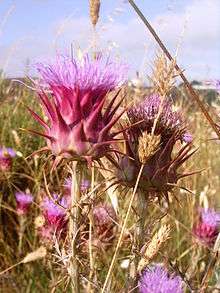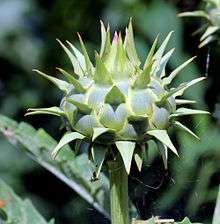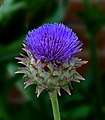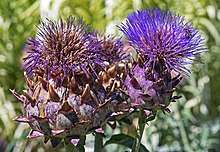Cardoon
The cardoon, Cynara cardunculus, also called the artichoke thistle, is a thistle in the sunflower family. It is a naturally occurring species that also has many cultivated forms, including the globe artichoke. It is native to the western and central Mediterranean region, where it was domesticated in ancient times and still occurs as a wild plant.
| Cardoon | |
|---|---|
 | |
| Plants in bloom, Sudoeste Alentejano e Costa Vicentina Natural Park, Portugal | |
| Scientific classification | |
| Kingdom: | |
| (unranked): | |
| (unranked): | |
| (unranked): | |
| Order: | |
| Family: | |
| Tribe: | |
| Genus: | |
| Species: | C. cardunculus |
| Binomial name | |
| Cynara cardunculus | |
| Synonyms[1] | |
| |
Description
The wild cardoon is a stout herbaceous perennial plant growing 0.8 to 1.5 m (31 to 59 in) tall, with deeply lobed and heavily spined green to grey-green tomentose (hairy or downy) leaves up to 50 cm (20 in) long, with yellow spines up to 3.5 cm long. The flowers are violet-purple, produced in a large, globose, massively spined capitulum up to 6 cm (2 in) in diameter.[2][3][4][5]
It is adapted to dry climates, native across a circum-Mediterranea area from Morocco and Portugal east to Libya and Greece and north to Croatia and Southern France;[6] it may also be native on Cyprus, the Canary Islands and Madeira.[7] In France, it only occurs wild in the Mediterranean south (Gard, Hérault, Aude, Pyrénées-Orientales, Corsica).[4] It has become an invasive weed in the pampas of Argentina,[5] and is also considered a weed in Australia and California.[8][9][10][11]
Cultivation
The two main cultivar groups are the cardoon (Cynara cardunculus Cardoon Group, syn. C. cardunculus var. altilis DC), selected for edible leaf stems, and the artichoke (Cynara cardunculus Scolymus Group, sometimes distinguished as Cynara scolymus or C. cardunculus var. scolymus (L.) Fiori), selected for larger edible flower buds. They differ from the wild plant in being larger (up to 2 m tall), much less spiny, and with thicker leaf stems and larger flowers, all characteristics selected by humans for greater crop yield and easier harvest and processing.[2][12] Wild and cultivated cardoons and artichokes are very similar genetically, and are fully interfertile, but only have very limited ability to form hybrids with other species in the genus Cynara.[2]
The earliest description of the cardoon may come from the fourth-century BC Greek writer Theophrastus, under the name κάκτος (Latin: cactus), although the exact identity of this plant is uncertain.[2] The cardoon was popular in Greek, Roman, and Persian cuisine, and remained popular in medieval and early modern Europe. It also became common in the vegetable gardens of colonial America, but fell from fashion in the late 19th century and is now very uncommon.
In Europe, cardoon is still cultivated in France (Provence, Savoie, Lyonnais), Spain, and Italy. In the Geneva region, where Huguenot refugees introduced it about 1685, the local cultivar Argenté de Genève ("Cardy")[13] is considered a culinary specialty. "Before cardoons are sent to table, the stalks or ribs are blanched tying them together and wrapping them round with straw, which is also tied up with cord, and left so for about three weeks".[14] Cardoons also are common vegetables in northern Africa, often used in Algerian or Tunisian couscous.
| Nutritional value per 100 g (3.5 oz) | |
|---|---|
| Energy | 71 kJ (17 kcal) |
4.07 g | |
| Dietary fiber | 1.6 g |
0.1 g | |
0.7 g | |
| Vitamins | Quantity %DV† |
| Thiamine (B1) | 2% 0.02 mg |
| Riboflavin (B2) | 3% 0.03 mg |
| Niacin (B3) | 2% 0.3 mg |
| Pantothenic acid (B5) | 7% 0.338 mg |
| Vitamin B6 | 9% 0.116 mg |
| Folate (B9) | 17% 68 μg |
| Vitamin C | 2% 2 mg |
| Minerals | Quantity %DV† |
| Calcium | 7% 70 mg |
| Iron | 5% 0.7 mg |
| Magnesium | 12% 42 mg |
| Manganese | 12% 0.256 mg |
| Phosphorus | 3% 23 mg |
| Potassium | 9% 400 mg |
| Sodium | 11% 170 mg |
| Zinc | 2% 0.17 mg |
| |
| †Percentages are roughly approximated using US recommendations for adults. Source: USDA Nutrient Database | |
Cardoon stalks can be covered with small, nearly invisible spines that can cause substantial pain if they become lodged in the skin. Several spineless cultivars have been developed to overcome this.
Cardoon requires a long, cool growing season (about five months), and while it is not particularly frost-sensitive, in heavier freezes it may lose its leaves and resprout, or in extended hard freezes, die. It also typically requires substantial growing space per plant, so is not much grown except where it is regionally popular.
In cultivation in the United Kingdom, this plant has gained the Royal Horticultural Society's Award of Garden Merit.[15][16]
Gastronomy
While the flower buds can be eaten much as small (and spiny) artichokes, more often the stems are eaten after being braised in cooking liquid. Cardoon stems are part of Lyonnaise cuisine (e.g. gratin de cardons). Only the innermost, white stalks are considered edible, and cardoons are therefore usually prepared for sale by protecting the leaf stalks from the sunlight for several weeks. This was traditionally done by burying the plant underground, thus, cardoon plantations in Spain are often formed by characteristic earth mounds surrounding each plant, the earth covering the stalks.[17] In modern cultivation, the plant is usually instead wrapped in black plastic film or other opaque material.
The flower buds of wild cardoons are still widely collected and used in southern Italy and Sicily.[18] In Spain and Portugal, the flower buds are also employed in cheesemaking: the pistils of the cardoon flower are used as a vegetable rennet in the making of some cheeses such as the Torta del Casar and the Torta de la Serena cheeses in Spain, or the Queijo de Nisa and Serra da Estrela cheeses in Portugal.
Cardoon leaf stalks, which look like giant celery stalks, can be served steamed or braised, and have an artichoke-like flavour with a hint of bitterness. They are harvested in winter and spring, being best just before the plant flowers.[12] In the Abruzzo region of Italy, Christmas lunch is traditionally started with a soup of cardoon cooked in chicken broth with little meatballs (lamb or, more rarely, beef), sometimes with the further addition of egg (which scrambles in the hot soup – called stracciatella) or fried chopped liver and heart.[19]
The cardoon stalks are considered a delicacy in Spain, particularly in the northerns regions of Navarre and Aragon, where they are grown in large quantities. In Spain, cardoons are typically cooked by first boiling the stalks to soften them, and then adding simple sauces such as almond sauce or small amounts of jamón; they are sometimes combined with clams, artichokes, or beans as well.
Because of their seasonality (from November to February), cardoons are a staple of the Christmas dinner in Navarre and the surrounding regions; for the same reason, cardoons are often sold as vegetable preserves, usually in water or brine, so that they can be eaten all year round. Cardoons are an ingredient in one of the national dishes of Spain, the cocido madrileño, a slow-cooking, one-pot, meat and vegetable dish simmered in broth.
In the US, it is rarely found in conventional grocery stores but is available in some farmers' markets in the months of May, June, and July. The main root can also be boiled and served cold.[21] The stems are also traditionally served battered and fried at St. Joseph's altars in New Orleans.
Cardoon is one of the herbs used to flavour Amaro liqueur, which may be called Cardamaro.
Other uses
Cardoons are used as a vegetarian source of enzymes for cheese production. In Portugal, traditional coagulation of the curd relies entirely on this vegetable rennet. This results in cheeses such as the Serra da Estrela and Nisa.
The cardoon is also grown as an ornamental plant for its imposing architectural appearance, with very bright silvery-grey foliage and large flowers in selected cultivars.[5]
Cardoon has attracted recent attention as a possible source of biodiesel fuel. The oil, extracted from the seeds of the cardoon, and called artichoke oil, is similar to safflower and sunflower oil in composition and use.[22]
Cardoon is the feedstock for the first biorefinery in the world converting the installations of a petrochemical plant in Porto Torres, Sardinia, providing biomass and oils for the building blocks of bioplastics.
Cardoons in Popular Culture
On the 27/04/20 Quiz Host Simon Hollingsworth and his daughter Ksenia Kulakova included a photograph of a cardoon during their wildly popular weekly quiz. Despite contestants having a combined IQ of over 14,000, not a single competitor recognised the cardoon. This knowledge gap has spawned a series of jokes and songs amongst the 'cardoon clique' and also an intense internet battle; 'Peterson-gate'
Gallery
 Cynara cardunculus - MHNT
Cynara cardunculus - MHNT- Young leaves of a spiny wild plant
 Inflorescence bud
Inflorescence bud Plants
Plants Bud
Bud Garden plant in bloom
Garden plant in bloom- Cultivated cardoons in Ágreda, Spain
 In bloom in a garden near Galveston
In bloom in a garden near Galveston- Cardoon prepared in the Navarrese way
 Cardoon plant in early August, Botanical Garden, Gaillac
Cardoon plant in early August, Botanical Garden, Gaillac A jar of pickled cardoon stalks.
A jar of pickled cardoon stalks. A Cynara cardunculus plant at anthesis bearing white flowers
A Cynara cardunculus plant at anthesis bearing white flowers
References
- "The Plant List: A Working List of All Plant Species". Retrieved 9 July 2014.
- Sonnante, G., Pignone, D, & Hammer, K. (2007). The Domestication of Artichoke and Cardoon: From Roman Times to the Genomic Age. Ann. Bot. 100: 1095–1100. Full text.
- "Malta's Native Flora". Archived from the original on 2009-05-12. Retrieved 2011-09-23.
- Tela Botanica: Cynara cardunculus L. Archived March 29, 2012, at the Wayback Machine (in French)
- Huxley, A., ed. (1992). New RHS Dictionary of Gardening. Macmillan ISBN 0-333-47494-5.
- Altervista Flora Italiana, Carciofo selvatico, Cardoon, Cynara cardunculus L. includes p hotos and European distribution map
- Euro+Med PlantBase Cynara cardunculus
- Flora of North America Cardoon, artichoke, artichoke thistle, Cynara scolymus L.
- Atlas of Living Australia. "Cynara cardunculus : Artichoke Thistle - Atlas of Living Australia". ala.org.au.
- Biota of North America Program 2014 county distribution map
- Calflora taxon report, University of California, Cynara cardunculus L., artichoke thistle, cardoon
- Plants for a future: Cynara cardunculus
- "BDN: Argenté de Genève (4-009-1)". bdn.ch. Archived from the original on 2014-11-10. Retrieved 2011-09-23.
- Vilmorin-Andrieux, M. & Robinson, W. (1885/undated). The vegetable garden: Illustrations, descriptions, and culture of the garden vegetables of cold and temperate climates. English Edition. Jeavons-Leler Press and Ten Speed Press. 1920 edition in Internet Archive
- "Cynara cardunculus AGM". Royal Horticultural Society. Retrieved 2020-04-17.
- "AGM Plants - Ornamental" (PDF). Royal Horticultural Society. July 2017. p. 22. Retrieved 24 January 2018.
- "Cardo - GuÃa de Hortalizas y Verduras - Consumer Eroski". consumer.es.
- Pignone, D, & Sonnante, G. (2004). Wild artichokes of south Italy: did the story begin here? Genetic Resources and Crop Evolution 51 (6): 577-580. Abstract
- "Brodo Con I Cardi (Ricetta tipica abruzzese)" [Cardoon soup (typical Abruzzese recipe)]. Cucina In Simpatia (in Italian). Archived from the original on 13 October 2016. Retrieved 13 October 2016.
- "Cardoon - General information". Michigan State University Extension. August 3, 1999. Archived from the original on 2005-02-07. Retrieved 2006-11-18.
- "Plant Oils Used for Bio-diesel". BDPedia.com, the Biodiesel WWW Encyclopedia. Retrieved 2006-11-18.
External links
